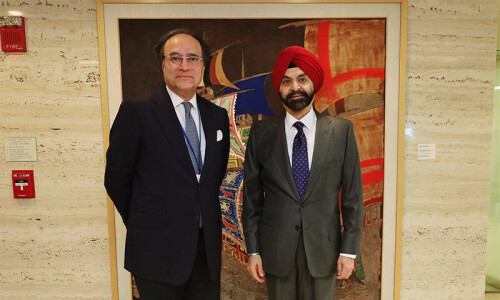The future looks bright and promising, as textile titans compete for a bigger share of the cotton lawn market. At the higher end, their focus seems to be on margins. But at the lower end, they are clearly pursuing volumes.
Many businessmen contacted by Dawn expect the ladies’ summer wear market to expand by 10pc in 2014 over the last year to an estimated Rs440 billion. In 2013, 10 million ladies’ cotton fabric suits were estimated to have been sold in six months (February to July), valued at Rs400 billion.
If things go as expected, the sales volume may shoot up by 5pc over the same period in this year. The price increase will bridge the remaining gap to realise the market expansion of 10pc in value terms.
The per suit price of leading brands this year, according to an insider, will range between Rs5,500 and Rs25,000, depending on the quality, design and accessories that go with the fabric. However, at ordinary shops, basic printed cotton fabric of coarse quality can be bought in the Rs400-1,200 range.
“The last three months have really been challenging. We have invested in fabric and brand building, struck deals with leading fashion designers, and beefed up our marketing team in the hope that it would help us sustain our market position,” the CEO of one of the Big-5 textile companies told this writer
“The huge spending to stay ahead of the rest at the start of the season has rendered our kitty dry. We are keeping our fingers crossed and are hoping for a rewarding outcome for that extra effort we put in,” he added.
“For finer quality fabric, longer staple varieties are imported from Egypt (Giza) and the US (Pima), for what we call 80 and 100 singles. Some Indian cotton is imported (60 singles). The local cotton, because of comparatively low quality, is used for bulk production, at best for 40 singles,” Tariq Mehmud, an Aptma ex-chairman told this scribe.
He hoped that on the strength of innovation, exposure in export markets and greater appreciation of the value of understanding taste and demands of consumers in developed markets, the local textile sector will expand its footprint globally.
“We are introducing matching garment sets for girls and their dolls in the US, and toying with several other new ideas to make inroads with our brands there with more attention to colours and designs to suit consumers’ tastes. It is challenging, but that is the way forward,” he said over phone.
On the question why textile companies dropped leading ladies of Indian cinema from their lawn advertisements, another textile tycoon said the practice had backfired.
“It promoted stars more than the brand they modelled for. There is no dearth of pretty faces in Pakistan, and companies want to attract customers’ attention with nice advertisements to influence their choice with the brand name,” he said.
Meanwhile, the market is said to be maturing after years of what many described as a mad rush, where everyone tried to enter the field to make a quick buck. “I know a tailor who held a lawn exhibition in 2011. Now, most people like that are out. People who are visible on the scene fall into one of the five emerging categories,” he commented.
Elaborating, he mentioned: brand ambassadors, who are celebrities signing up to promote a brand; recognised designers teaming up with established textile companies; designers getting fabric with their signature designs made to order; big brands manufacturing and marketing at specialised theme stores besides the open market; and base fabric providers, mostly in Faisalabad.
Market observers identified Gul Ahmed, Nishat, Al Karam, Orient and Lakhani textiles as the five biggies with a deep imprint on the local market.
“Without naming names, I can tell you that some, if not all of them, are also involved in copying their own designs onto cheaper materials for the middle and lower class customer bases,” an insider told Dawn.
“To deal with the issue of copying, the big boys have come up with the concept of introducing several editions at intervals throughout the season. How can the begum tolerate her maid wearing the same design that she bought from an exhibition? To stay ahead of the rest, elite class ladies regularly return to the market for fresh stuff,” another CEO of one of the five top textile companies explained.
















































Dear visitor, the comments section is undergoing an overhaul and will return soon.